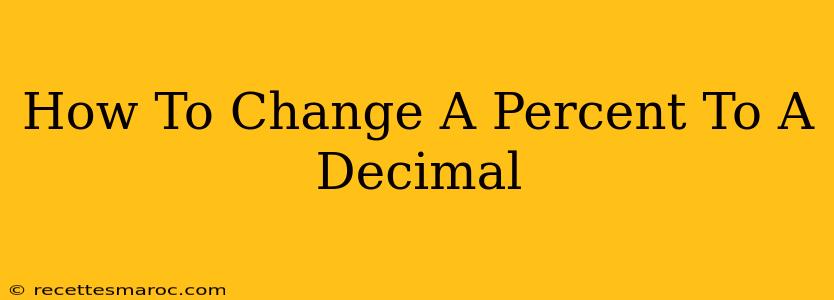Converting percentages to decimals is a fundamental skill in math, crucial for various applications from calculating discounts to understanding financial reports. This simple guide will walk you through the process, providing clear explanations and examples to ensure you master this essential conversion.
Understanding Percentages and Decimals
Before diving into the conversion, let's briefly review what percentages and decimals represent:
-
Percentage: A percentage represents a fraction of 100. The symbol "%" signifies "out of 100". For example, 50% means 50 out of 100, or 50/100.
-
Decimal: A decimal is a number expressed in the base-10 numeral system, using a decimal point to separate the whole number from the fractional part. For example, 0.5 represents one-half.
The Simple Conversion Method: Divide by 100
The most straightforward way to convert a percentage to a decimal is to divide the percentage by 100. This is because a percentage is essentially a fraction with a denominator of 100.
Here's the formula:
Decimal = Percentage / 100
Example 1:
Convert 75% to a decimal.
- Divide 75 by 100: 75 / 100 = 0.75
- Therefore, 75% is equal to 0.75
Example 2:
Convert 2.5% to a decimal.
- Divide 2.5 by 100: 2.5 / 100 = 0.025
- Therefore, 2.5% is equal to 0.025
Example 3: Converting a percentage greater than 100%
Convert 125% to a decimal
- Divide 125 by 100: 125/100 = 1.25
- Therefore, 125% is equal to 1.25
A Shortcut: Moving the Decimal Point
A quicker method involves moving the decimal point two places to the left. Remember that if a percentage doesn't explicitly show a decimal point (like 75%), it's understood to be at the end of the number (75.0%).
Example 4 (using the shortcut):
Convert 30% to a decimal.
- The decimal point is currently at the end: 30.0%
- Move the decimal point two places to the left: 0.30 (or simply 0.3)
- Therefore, 30% is equal to 0.3
Practical Applications: Why This Conversion Matters
Understanding how to convert percentages to decimals is essential for various real-world scenarios, including:
- Financial Calculations: Calculating interest rates, discounts, taxes, and profit margins.
- Statistical Analysis: Interpreting data presented as percentages.
- Scientific Calculations: Working with proportions and ratios.
- Everyday Life: Determining sale prices, tips, or understanding survey results.
Mastering this simple conversion empowers you to handle a wide range of numerical problems with confidence and accuracy. Practice with different percentages to solidify your understanding and build fluency. Remember, the key is to divide by 100, or move the decimal point two places to the left.

